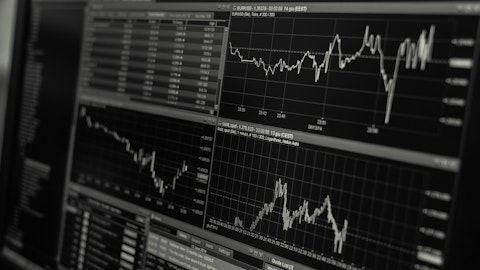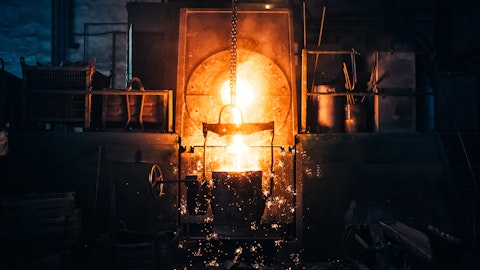John Hollatz: Yes, thank you, Leon. As Leon mentioned, we’re really proud of what our Seattle team has delivered since we bought that mill with the acquisition of Birmingham Steel in 2002. And our team has also done a really good job of positioning us for future success in this market. We’re really optimistic about the growth opportunities that we see in the Pacific Northwest and in the Canadian markets. The challenge that we faced with our Seattle facility is it’s been in its current location since 1905. And the mill sits on a very small footprint. Over the last century, the city has really grown around us, which has limited our ability to grow our capacity and our capabilities. So the strategy here is really to position Nucor for success for the next 50 years to take advantage of the cost and the efficiencies that we’ve experienced with our micromill technology as well as increasing our product offerings.
We’re certainly well aware of all of the other mills that have been announced. We’re following those projects closely. We’re really not in a position to speak on that. But we’re excited about what we’re doing at Kingman. We’re excited about what we have coming up in Lexington as well.
Tristan Gresser: All right, I appreciate the color. Thank you very much.
Operator: The next question is from Carlos de Alba of Morgan Stanley. Please go ahead.
Carlos de Alba: Yes, good morning everyone. So — just on the steel products, the steel fabrication business, you did mention that profitability has moderated, although it remains quite strong above pre-COVID levels. Can you provide a little bit more color regarding your order book, your backlog? Where does it extend to? And any sort of magnitude of the potential deceleration — continued deceleration, if that is what you’re seeing in the fourth quarter and perhaps into the 2024 year in terms of pricing and volumes, anything will be quite important for us.
Leon Topalian: Yes. Carlos, thanks for the question. I’ll kick it off and then maybe ask Brad True to comment. Obviously, we’re not going to give you pricing speculation into the back half of this year in door 2024. But here’s what I would tell you and I think context becomes really important as we talk about our steel products segment of our business. Again, it’s generating now 40% of our overall net earnings, and that’s been an incredible opportunity for Nucor. We’ve had seven straight quarters where they generated $1 billion or more. And so again, over the last seven quarters, it generated $7 billion in earnings. It’s been an incredible platform for us to continue to grow and continue to think about the diversity of mix that we bring to the marketplace, but it is softening.
It is coming down from our peak highs and historic highs in ’21, ’22 season. And so again, they’re moderating, but there’s no cliff. We’re not seeing this — the order books dry up. We’re seeing softening in backlog. But again, as compared to sort of pre-pandemic levels, those backlogs are up 20%, 25% still over that period of time. So again, it’s softening, but I would tell you that we are still optimistic about as we finish 2023 and head into ’24, some of those backlogs are extending out into Q2 already with favorable pricing. So Brad, do you want to add any more detail on that?
Brad True: Yes. Thanks, Leon. As Leon mentioned, backlogs have come down some, but are still well above pre-pandemic levels. And we have strong pricing in our backlog. We’ll see some seasonal slowdown as we normally do this time of year. But we’ll still have great results and strong earnings in Q4. One thing I would mention in addition is our diverse product portfolio continues to differentiate Nucor. While we saw moderating pricing and volume mainly driven by warehouse demand in our joist and deck business. We saw near record and record earnings in our pre-engineered metal buildings businesses, our insulated metal panel business and rebar fab. All three had stronger earnings quarter-over-quarter. And again, we’ll see some seasonal slowdown in construction, but we really believe there’s been a structural shift in the earnings profile of our fab product businesses.
The other thing we’re seeing is a lot of cross-selling opportunities. We are bringing multiproduct solutions to our customers that bring value to them, bring value to Nucor in a way of we’ve never done in the past.
Carlos de Alba: All right. Thanks for that. And just if I could maybe press on the point. What do you think has changed versus pre-pandemic conditions that have allowed the company to command a much higher price and therefore, much higher margins than it did in the past. Is there any — like can you point us to something fundamentally different than what we had before because the construction market is softening, as you mentioned. So wouldn’t that potentially make the market a little bit looser and therefore, reduce your pricing?
Leon Topalian: Carlos, look, what I would touch on immediately out of the gate is what Brad just mentioned, which is our product breadth is a key differentiator. So again, we are not under Damian [ph] the entire commercial team at Nucor. We’re approaching that market to look and say, how do we provide a solution set not just provide and sell a product. So our teams, our Construction Solutions group, our Energy Solutions groups are going out now and meeting with customers attaching them to maybe areas and products that weren’t traditionally purchased either mill direct or that weren’t coupled together that we now can bring to bear as an entire offering to provide a solution set. As we think about the manufacturing build out and warehouse build out, how do we now look to offer, again, the complete solution, not just in piece or part on and product of.
And so I would tell you that is gaining a lot of traction and intention. The other piece is the sustainability. There’s a lot of people that are trademarked and branded their products in the green space, but very few, if any, in the world at our scale. And so the scale of which we’re running our iconic products and net zero products today is getting a lot of attention and not just through the OEMs in automotive. It’s a much more diverse customer set today that we’re seeing that are demanding those products anything in the industry.
Carlos de Alba: Great. Thank you. Sorry, [indiscernible].
Steve Laxton: Add one other element to that. You’ll recall you followed us for a long time, but Nucor took some actions several years ago to restructure a few different businesses in that downstream steel products group. And while that’s not something we really love doing. The teams did a wonderful job to bring efficiencies within our own systems there to use it. But the predominant reason is exactly what Leon outlined.
Carlos de Alba: All right. Great. Thank you.
Leon Topalian: Thanks, Carlos.
Operator: The next question is from Bill Peterson of JPMorgan. Please go ahead.
Bill Peterson: Yes. Hi. Thanks for taking the questions. A couple, I guess, market-related questions. So if we think about the steel market today, I’m trying to get a sense of how you’re anticipating the market reactions to maybe a prolonged UAW strike versus maybe in the median end and especially in the context of we’ve seen some mill discipline in the past few months, some of the maintenance extended. Just to get a sense of how the reaction would be under those two scenarios?
Leon Topalian: Yes, I’ll start us off with the first one. And I’m not sure I fully caught the second part of the question, Bill, but if I don’t, please just reask that second half. Nucor’s exposure to automotive today is about 1.5 million tons. So we don’t — that’s 5% or 6% of our overall volume. So it’s not a huge exposure for us directly. Obviously, we’re watching in the automotive sector in the United States and the U.S. economy. We’ll potentially the longer it goes, have a more profound impact to the overall industry. But the part that Nucor remains excited and very committed to is to doubling that capacity over the next 3 to 5 years to moving from 1.5 million tons to about 3 million tons of our overall volume and footprint.




